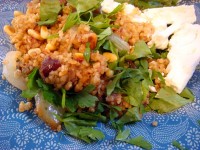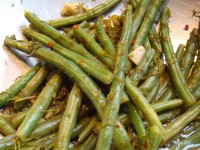Podcast: Play in new window | Download
This week, I make an easy, summery pasta dish, plus arugula that’s a nice variation from the usual salad. It all comes together very quickly, and doesn’t heat up the kitchen much–great when the weather is hot.
Shopping list
-
- 1 lemon
-
- Bunch fresh basil
-
- Bunch fresh arugula
-
- Spaghetti (at least 1/2 lb.)
-
- Pine nuts (about 1/4 cup)
-
- Butter (about 4 tablespoons)
-
- Parmesan cheese (a half-inch chunk)
-
- Olive oil (a drizzle)
-
- Fish sauce (a few drops)
- Red pepper flakes
Spaghetti with Lemon and Basil
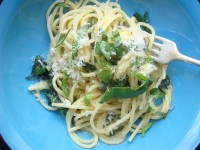 I cook this all the time in the summer–there’s something about the flavor combination that’s so refreshing, and in the summer, I don’t really feel like I need a big meaty main dish. I learned the recipe from a surprisingly good free promotional cookbook I got from the Parmigiano-Reggiano people a good ten years ago, and to be fair, the quality of the grating cheese does make a difference. So use Parmigiano-Reggiano, ideally, or, in a budgetary pinch, Grana Padano, though you’re not using so much that genuine Parm will break the bank.
I cook this all the time in the summer–there’s something about the flavor combination that’s so refreshing, and in the summer, I don’t really feel like I need a big meaty main dish. I learned the recipe from a surprisingly good free promotional cookbook I got from the Parmigiano-Reggiano people a good ten years ago, and to be fair, the quality of the grating cheese does make a difference. So use Parmigiano-Reggiano, ideally, or, in a budgetary pinch, Grana Padano, though you’re not using so much that genuine Parm will break the bank.
For 2 servings
1 lemon
Large handful fresh basil leaves
Half-inch chunk of Parmesan
3-4 tablespoons butter
1/2 pound spaghetti
Salt, to taste
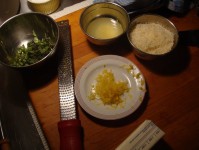 Set a pot with heavily salted water on to boil. Then get all the pasta ingredients ready (as in the photo): grate the zest from the lemon into a small bowl, then squeeze the lemon juice into another small bowl–you’ll want about 1 tablespoon total, maybe a dash more. Rinse the basil well, then slice into thin strips. Grate the Parmesan cheese–you should have about 1/3 cup. Measure out your butter.
Set a pot with heavily salted water on to boil. Then get all the pasta ingredients ready (as in the photo): grate the zest from the lemon into a small bowl, then squeeze the lemon juice into another small bowl–you’ll want about 1 tablespoon total, maybe a dash more. Rinse the basil well, then slice into thin strips. Grate the Parmesan cheese–you should have about 1/3 cup. Measure out your butter.
In a heavy skillet (the same one you will have prepared the arugula in is fine) on medium heat, melt the butter, then add the lemon zest and juice and let simmer for a minute or so. (You can do this part in advance and let it sit until the pasta is cooked.)
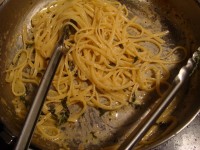 Cook the pasta according to the package directions–usually 6-8 minutes. When it’s just al dente (err toward less done), set aside a bit of the pasta water in a mug, then drain the rest of the pasta. Toss it into the skillet with the butter (turn the heat back on to medium, if it has been sitting), and stir the pasta to coat evenly (tongs are good here). Gradually shake in all but about 1 tablespoon of the cheese, stirring the pasta constantly. If the mixture gets a bit dry or too sticky (as in the photo), add a tablespoon or two of the reserved pasta water. Finally, toss in the basil and turn off the heat. Taste for salt (you may not need any if you’ve salted your pasta water well, and used salted butter). Serve with the reserved cheese sprinkled on top.
Cook the pasta according to the package directions–usually 6-8 minutes. When it’s just al dente (err toward less done), set aside a bit of the pasta water in a mug, then drain the rest of the pasta. Toss it into the skillet with the butter (turn the heat back on to medium, if it has been sitting), and stir the pasta to coat evenly (tongs are good here). Gradually shake in all but about 1 tablespoon of the cheese, stirring the pasta constantly. If the mixture gets a bit dry or too sticky (as in the photo), add a tablespoon or two of the reserved pasta water. Finally, toss in the basil and turn off the heat. Taste for salt (you may not need any if you’ve salted your pasta water well, and used salted butter). Serve with the reserved cheese sprinkled on top.
Wilted Arugula with Pine Nuts
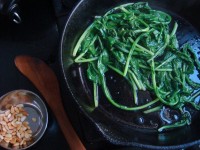 This preparation takes a little of the intense peppery bite out of arugula, so give it a try even if you’re not ordinarily an arugula fan. And the basic technique–wilting greens with a little bit of liquid in a hot, covered pan–is one you can apply to all kinds of greens. Pine nuts add a little crunch and additional protein, to make the dish just a tad more substantial. Fish sauce is optional (a shortcut to melting anchovies in the hot olive oil before adding the greens), but it adds just a touch of extra richness. To save on cleanup, you can make it in the same pan you’ll later finish the pasta in.
This preparation takes a little of the intense peppery bite out of arugula, so give it a try even if you’re not ordinarily an arugula fan. And the basic technique–wilting greens with a little bit of liquid in a hot, covered pan–is one you can apply to all kinds of greens. Pine nuts add a little crunch and additional protein, to make the dish just a tad more substantial. Fish sauce is optional (a shortcut to melting anchovies in the hot olive oil before adding the greens), but it adds just a touch of extra richness. To save on cleanup, you can make it in the same pan you’ll later finish the pasta in.
For 2 servings
1 medium bunch fresh arugula
Olive oil
2 small handfuls pine nuts
Fish sauce (or salt)
Pinch red pepper flakes (Aleppo pepper is ideal; Italian pepper flakes will do too)
Rinse your arugula very well, but no need to dry. Set a heavy skillet over medium heat and drizzle in a glug of olive oil. When the pan is hot, toss in the pine nuts and stir occasionally till nicely browned, usually less than a minute. Remove the nuts and set aside.
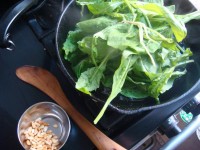 Throw the wet arugula in the pan, and stand back a bit to avoid any spattering oil. (If you’re starting with dry greens, toss them in, then add a tablespoon or two of water.) They won’t look like it’s all going to fit (as in the photo), but as you stir quickly (tongs can be useful here) to coat the leaves with oil, they will start to wilt immediately. Then put the lid on the pan and turn the heat to medium-low. Cook, covered, for just 20-30 seconds, until the arugula is completely wilted, but still bright green.
Throw the wet arugula in the pan, and stand back a bit to avoid any spattering oil. (If you’re starting with dry greens, toss them in, then add a tablespoon or two of water.) They won’t look like it’s all going to fit (as in the photo), but as you stir quickly (tongs can be useful here) to coat the leaves with oil, they will start to wilt immediately. Then put the lid on the pan and turn the heat to medium-low. Cook, covered, for just 20-30 seconds, until the arugula is completely wilted, but still bright green.
Remove the greens from the pan immediately to stop the cooking, then drizzle on a few drops of fish sauce (if you have it) and stir. If you want to stay veggie, or you don’t have fish sauce, just sprinkle on a bit of salt. Top with red pepper flakes and serve. (This can sit and cool a little–it doesn’t need to be served piping hot.)

